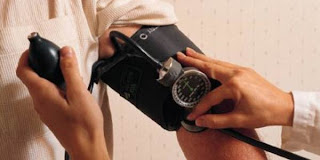Nursing Diagnosis Knowledge Deficit Nursing Diagnosis - Hypertension
Knowledge Deficit reated to the lack of information about the disease process and self-care.
Purpose: Clients are met in the information about hypertension
Nursing Interventions :
a. Explain the nature and purpose of the treatment of diseases and procedures.
b. Explain the importance of a quiet neighborhood, not stressful.
c. Discuss medications: name, dose, time of administration, purpose and side effects or toxic effects.
d. Explain the need to avoid the use of drugs, without a doctor's examination.
e. Discuss symptoms of relapse or progression of complications for physicians reported: headache, dizziness, fainting, nausea and vomiting.
f. Discuss the importance of maintaining a stable weight.
g. Discuss the importance of avoiding fatigue and weight lifting.
h. Discuss the need for a low-calorie, low-sodium to order.
i. Explain the importance of maintaining proper fluid intake, amount allowed, restrictions such as caffeinated coffee, tea and alcohol.
j. Explain the need to avoid constipation and detention.
Expected results:
Patients express knowledge and management skills early treatment
Reported the use of drugs to order
Nursing Care Plan Hypertension
Sabtu, 29 September 2012
Jumat, 28 September 2012
Nursing Diagnosis Risk for ineffective Tissue Perfusion - Hypertension
Nursing Diagnosis Risk for ineffective Tissue Perfusion - Hypertension
Risk for ineffective Tissue Perfusion: cerebral, renal, cardiac related to circulatory disorders
Purpose: uninterrupted circulation
Nursing Intervention:
a. Maintain bed rest; elevate the head of the bed
b. Assess blood pressure at admission in both arms; sleeping, sitting with arterial pressure monitoring if available.
c. Keep fluids and medications to order.
d. Observe the sudden hypotension.
e. Measure the input and output.
f. Monitor electrolytes, BUN, creatinine to order.
g. Ambulation according to ability; avoid fatigue. .
Expected results: Patients demonstrating an improved tissue perfusion as indicated by: blood pressure within acceptable limits, no complaints of headaches, dizziness, laboratory values within normal limits. Urine output of 30 mL / min Vital signs are stable
Risk for ineffective Tissue Perfusion: cerebral, renal, cardiac related to circulatory disorders
Purpose: uninterrupted circulation
Nursing Intervention:
a. Maintain bed rest; elevate the head of the bed
b. Assess blood pressure at admission in both arms; sleeping, sitting with arterial pressure monitoring if available.
c. Keep fluids and medications to order.
d. Observe the sudden hypotension.
e. Measure the input and output.
f. Monitor electrolytes, BUN, creatinine to order.
g. Ambulation according to ability; avoid fatigue. .
Expected results: Patients demonstrating an improved tissue perfusion as indicated by: blood pressure within acceptable limits, no complaints of headaches, dizziness, laboratory values within normal limits. Urine output of 30 mL / min Vital signs are stable
Kamis, 27 September 2012
Acute Pain - Nursing Diagnosis Hypertension
Acute Pain - Nursing Diagnosis Hypertension
Acute Pain: headache related to increased cerebral vascular pressure
Purpose: The pressure does not increase cerebral vascular
Nursing interventions:
Maintain bed rest, quiet neighborhood, a little illumination.
Minimize disturbance and environmental stimuli.
Limit activity.
Avoid smoking or the use the use of nicotine.
Give analgesia and sedation drugs to order.
Give a fun action as an indication like an ice pack, a comfortable position, relaxation techniques, counseling imagination, avoid constipation.
Expected results: Patients revealed no headache and looked comfortable
Acute Pain: headache related to increased cerebral vascular pressure
Purpose: The pressure does not increase cerebral vascular
Nursing interventions:
Maintain bed rest, quiet neighborhood, a little illumination.
Minimize disturbance and environmental stimuli.
Limit activity.
Avoid smoking or the use the use of nicotine.
Give analgesia and sedation drugs to order.
Give a fun action as an indication like an ice pack, a comfortable position, relaxation techniques, counseling imagination, avoid constipation.
Expected results: Patients revealed no headache and looked comfortable
Risk for Decreased Cardiac Output - Nursing Diagnosis Hypertension
Risk for Decreased Cardiac Output - Nursing Diagnosis Hypertension
Risk for Decreased cardiac output related to increased afterload, vasoconstriction, myocardial ischemia, ventricular hypertrophy
Purpose: afterload is not increased, there was no vasoconstriction, no myocardial ischemia
Nursing interventions:
Risk for Decreased cardiac output related to increased afterload, vasoconstriction, myocardial ischemia, ventricular hypertrophy
Purpose: afterload is not increased, there was no vasoconstriction, no myocardial ischemia
Nursing interventions:
- Monitor blood pressure, measured in both hands, use the cuff and proper technique.
- Note the presence, quality of central and peripheral pulses.
- Tone auscultation of heart and breath sounds.
- Observe skin color, moisture, temperature and capillary refill time.
- Note the general edema.
- Provide a quiet, comfortable, reduce the activity.
- Maintain restrictions on activities such as rest in bed / chair.
- Help the patient perform self-care activities as needed.
- Perform actions such as a comfortable back and neck massage.
- Encourage relaxation techniques, your imagination, the transfer activity.
- Monitor response to medication to control blood pressure.
- Give diet fluid and sodium restriction as indicated.
- Collaboration for the provision of drugs as indicated.
- Participate in activities that lower blood pressure.
- Maintaining blood pressure within an acceptable range.
- Showed stable cardiac rhythm and frequency.
Rabu, 26 September 2012
Controlling and Preventing High Blood Pressure
Controlling and Preventing High Blood Pressure
For those of you who still have normal blood pressure or high blood pressure for those who already have high blood pressure, the following practical suggestions you can do: Reduce consumption of salt in your food. If you already have high blood pressure you should avoid foods that contain salt. Consumption of foods containing potassium, magnesium and calcium. Potassium, magnesium and calcium can reduce high blood pressure. Reduce drinking alcoholic beverages or food. If you suffer from high blood pressure, you should avoid excessive alcohol consumption. For men who suffer from hypertension, amount of alcohol is permitted a maximum of 30 ml of alcohol per day while women 15 ml per day.
Regular exercise can lower high blood pressure. If you suffer from high blood pressure, choose light exercise such as walking, cycling, running relaxed, and swimming. Do it for 30 to 45 minutes a day 3 times a week. Eat vegetables and fruits that are high in fiber such as green vegetables, bananas, tomatoes, carrots, cantaloupe, and oranges. Run anti-stress therapy to reduce stress and you are able to control your emotions. Quitting smoking also contributes greatly to reducing high blood pressure or hypertension. Control your cholesterol and control of your diabetes.
Avoid drugs that can increase blood pressure. Consult your doctor if you are receiving treatment for a particular disease, to ask for drugs that do not increase blood pressure. High Blood can DikendalikanTekanan high blood pressure or hypertension is not a disease that can not be eliminated. You can control and prevent high blood pressure.
For those of you who still have normal blood pressure or high blood pressure for those who already have high blood pressure, the following practical suggestions you can do: Reduce consumption of salt in your food. If you already have high blood pressure you should avoid foods that contain salt. Consumption of foods containing potassium, magnesium and calcium. Potassium, magnesium and calcium can reduce high blood pressure. Reduce drinking alcoholic beverages or food. If you suffer from high blood pressure, you should avoid excessive alcohol consumption. For men who suffer from hypertension, amount of alcohol is permitted a maximum of 30 ml of alcohol per day while women 15 ml per day.
Regular exercise can lower high blood pressure. If you suffer from high blood pressure, choose light exercise such as walking, cycling, running relaxed, and swimming. Do it for 30 to 45 minutes a day 3 times a week. Eat vegetables and fruits that are high in fiber such as green vegetables, bananas, tomatoes, carrots, cantaloupe, and oranges. Run anti-stress therapy to reduce stress and you are able to control your emotions. Quitting smoking also contributes greatly to reducing high blood pressure or hypertension. Control your cholesterol and control of your diabetes.
Avoid drugs that can increase blood pressure. Consult your doctor if you are receiving treatment for a particular disease, to ask for drugs that do not increase blood pressure. High Blood can DikendalikanTekanan high blood pressure or hypertension is not a disease that can not be eliminated. You can control and prevent high blood pressure.
High Blood Pressure Lowering Foods
High blood pressure, once it occurs more frequently in older people, but now many young women experience. The condition can lead to heart attack, stroke and aneurysm.
The term blood pressure refers to the force of blood as it moves through the arteries. This pressure is not always constant, and when the pressure is high in the long term, then there is high blood pressure or hypertension.
So you avoid these blood pressure disorders, consume some of the following foods on a regular basis.
1. Spinach
Spinach is an excellent source of magnesium. Not only protect you from heart disease, but can also reduce blood pressure. In addition, the folate content in spinach can protect the body from homocysteine which makes harmful chemicals. Research has shown that high levels of the amino acid (homocysteine) can cause heart attacks and strokes.
2. Sunflower seeds
Maybe you know him as the watermelon seeds. Very high content of magnesium and sunflower seeds contains phytosterols, which can reduce cholesterol levels in the body. High cholesterol is a precursor to high blood pressure, because it can cause blockage of blood vessels. But, make sure you are not eating fresh watermelon seeds with salt.
3. Nuts
Nuts, such as peanuts, almonds, kidney beans contain magnesium and potassium. Potassium is known to be quite effective in lowering high blood pressure.
4. Banana
The fruit is not only delicious but also offers a sense of making a healthier bloo
d pressure. Bananas contain potassium and high in fiber are beneficial to prevent heart disease. Research also shows that one banana a day is enough to help prevent high blood pressure.
5. Soybean
There are many advantages to consume soy to your health. One of them dalah lower bad cholesterol and high blood pressure. Content isoflavonnya is very beneficial for health.
6. Potato
Nutrition is often lost because of the potato to cook unhealthy. Though the minerals, fiber and potassium in potatoes is very high which is very good for stabilizing blood pressure.
7. Dark chocolate (dark chocolate)
Chocolate lovers will surely be delighted, because the content of flavonoids in chocolate may help lower blood pressure by stimulating the production of nitric oxide. Nitric oxide makes the signal muscles surrounding blood vessels to relax more, and caused increased blood flow.
8. Avocado
Oleic acid in avocados, can help reduce cholesterol. In addition, the content of potassium and folic acid, is essential for heart health. (Umi)
The term blood pressure refers to the force of blood as it moves through the arteries. This pressure is not always constant, and when the pressure is high in the long term, then there is high blood pressure or hypertension.
So you avoid these blood pressure disorders, consume some of the following foods on a regular basis.
1. Spinach
Spinach is an excellent source of magnesium. Not only protect you from heart disease, but can also reduce blood pressure. In addition, the folate content in spinach can protect the body from homocysteine which makes harmful chemicals. Research has shown that high levels of the amino acid (homocysteine) can cause heart attacks and strokes.
2. Sunflower seeds
Maybe you know him as the watermelon seeds. Very high content of magnesium and sunflower seeds contains phytosterols, which can reduce cholesterol levels in the body. High cholesterol is a precursor to high blood pressure, because it can cause blockage of blood vessels. But, make sure you are not eating fresh watermelon seeds with salt.
3. Nuts
Nuts, such as peanuts, almonds, kidney beans contain magnesium and potassium. Potassium is known to be quite effective in lowering high blood pressure.
4. Banana
The fruit is not only delicious but also offers a sense of making a healthier bloo
d pressure. Bananas contain potassium and high in fiber are beneficial to prevent heart disease. Research also shows that one banana a day is enough to help prevent high blood pressure.
5. Soybean
There are many advantages to consume soy to your health. One of them dalah lower bad cholesterol and high blood pressure. Content isoflavonnya is very beneficial for health.
6. Potato
Nutrition is often lost because of the potato to cook unhealthy. Though the minerals, fiber and potassium in potatoes is very high which is very good for stabilizing blood pressure.
7. Dark chocolate (dark chocolate)
Chocolate lovers will surely be delighted, because the content of flavonoids in chocolate may help lower blood pressure by stimulating the production of nitric oxide. Nitric oxide makes the signal muscles surrounding blood vessels to relax more, and caused increased blood flow.
8. Avocado
Oleic acid in avocados, can help reduce cholesterol. In addition, the content of potassium and folic acid, is essential for heart health. (Umi)
Senin, 24 September 2012
10 Most Common Causes of Hypertension
'
There are several things that can cause a person to have hypertension. There are factors that cause hypertension that you can not control. There is also that you can control so that it can tackle hypertension. Some of these factors include:
1. Descent
This factor can not you control. If someone has a parent or sibling who has hypertension, then it is likely he suffered from hypertension greater. Statistics show that the problem of high blood pressure is higher in identical twins than identical twins are not. A study showed that there is evidence derived genes for hypertension problem.
2.Age
This factor can not you control. Research shows that as people grow older, blood pressure will rise. You can not expect that your blood pressure will be the same as young as you get older. But you can control so as not to pass the upper limit of normal.
3. Salt
These factors can you control. Salt can increase blood pressure in some people quickly, especially for diabetics, people with mild hypertension, people with old age, and those who were black.
4. Cholesterol
These factors can you control. Excess fat in your blood, it can cause cholesterol deposits in blood vessel walls. It can make blood vessels constrict and blood pressure will increase as a result. Control your cholesterol as early as possible. For tips on controlling cholesterol.
5. Obesity / Overweight
These factors can you control. People who have a body weight above 30 percent ideal body weight, are more likely to suffer from high blood pressure.
6. Stress
These factors can you control. Stress and emotionally unstable conditions can also trigger high blood pressure.
7. Cigarette
These factors can you control. Smoking can also increase blood pressure to be high. Smoking habits may increase the risk of diabetes, heart attack and stroke. Therefore, smoking habits continued when having high blood pressure, is a very dangerous combination that will trigger diseases related to heart and blood.
8. Caffeine
These factors can you control. Caffeine is found in coffee, tea and cola drinks can cause increased blood pressure.
9. Alcohol
These factors can you control. Excessive alcohol consumption also causes high blood pressure.
10. Lack of exercise
These factors can you control. Lack of exercise and movement can cause increased blood pressure in the body. Regular exercise can lower your high blood pressure but do not do heavy exercise if you suffer from high blood pressure.
1. Descent
This factor can not you control. If someone has a parent or sibling who has hypertension, then it is likely he suffered from hypertension greater. Statistics show that the problem of high blood pressure is higher in identical twins than identical twins are not. A study showed that there is evidence derived genes for hypertension problem.
2.Age
This factor can not you control. Research shows that as people grow older, blood pressure will rise. You can not expect that your blood pressure will be the same as young as you get older. But you can control so as not to pass the upper limit of normal.
3. Salt
These factors can you control. Salt can increase blood pressure in some people quickly, especially for diabetics, people with mild hypertension, people with old age, and those who were black.
4. Cholesterol
These factors can you control. Excess fat in your blood, it can cause cholesterol deposits in blood vessel walls. It can make blood vessels constrict and blood pressure will increase as a result. Control your cholesterol as early as possible. For tips on controlling cholesterol.
5. Obesity / Overweight
These factors can you control. People who have a body weight above 30 percent ideal body weight, are more likely to suffer from high blood pressure.
6. Stress
These factors can you control. Stress and emotionally unstable conditions can also trigger high blood pressure.
7. Cigarette
These factors can you control. Smoking can also increase blood pressure to be high. Smoking habits may increase the risk of diabetes, heart attack and stroke. Therefore, smoking habits continued when having high blood pressure, is a very dangerous combination that will trigger diseases related to heart and blood.
8. Caffeine
These factors can you control. Caffeine is found in coffee, tea and cola drinks can cause increased blood pressure.
9. Alcohol
These factors can you control. Excessive alcohol consumption also causes high blood pressure.
10. Lack of exercise
These factors can you control. Lack of exercise and movement can cause increased blood pressure in the body. Regular exercise can lower your high blood pressure but do not do heavy exercise if you suffer from high blood pressure.
Langganan:
Komentar (Atom)


